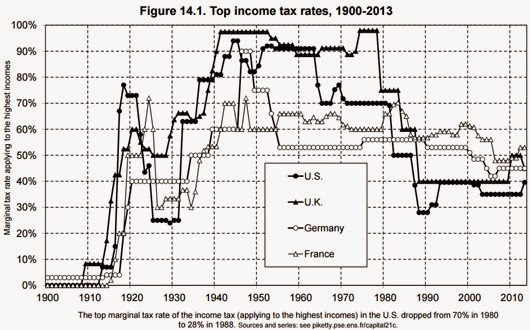ピケティの資本論 10: 格差の何が問題か 1
* 1
Until now, we looked at the aspect of economic disparity.
Here, I marshal the issue of the disparity.
これまで、格差の側面を数々見てきました。
ここで格差の問題を整理しておきます。
Preface
Generally, it is said that the disparity is not good.
Political philosopher John Rawls made an issue of the disparity in “A Theory of Justice (1971)”, and did the following proposals.
The difference principle: if at all possible, our society must improve the worst situation due to the society and economic disparity that have occurred accordingly.
The equal opportunity principle: our society must maximize the benefits of unhappy people along with making the conditions of fair equality of opportunity in the society and economy.
Nevertheless, if the disparity correction is connected to the violation of rights and the economic slowdown, many people may hesitate to ask for the disparity correction.
Therefore, first I confirm that there are what kinds of the issues about the economic disparity.
はじめに
一般的に、格差は良くないとされています。
米国の哲学者ジョン・ロールズは「正義論」において格差を問題にし、以下の提言をしています。
格差原理: 結果的に発生した社会的・経済的不平等に対しては、最悪の状況を可能な限り改善する。
機会均等原理: 社会的または経済的な不平等を機会の均等を図りながら、最も不遇な人々の利益を最大化する。
しかしそうは言っても、格差是正を権利の侵害や経済減速と結びつけられると、多くの人は格差是正に二の足を踏んでしまいます。
そこで格差にはどんな問題があるかを先ず確認しておきます。
* 2
The definition of the disparity
The disparity is a state having a bad influence on one society due to the big differences of the income and the asset are immobilized.
格差とは
ここでは、同一社会で所得と総資産に大きな隔たりがあり、それが固定化され、社会に悪影響を与えている状態とします。
Some issues that I pointed out so far
I summarize the issues.
For details, please see " ** -- : --- " in each section.
For to see this, " series : Capital of Piketty " of category is convenient.
これまでに指摘した問題点
今までに見てきた問題点を要約します。
詳しくは、各項の「** : 」を見て下さい。
これを見るには「カテゴリー」の「連載 ピケティの資本論」からが便利です。
l The large reward that isn’t rational declines the motivation. “ ** 2: Big paycheck”
Many rewards aren’t rational, because it don’t get a fair evaluation, but rather are decided by arbitrariness.
In this case, every deviant act becomes common, and the decline in motivation and the dissatisfaction will spread soon.
l An expensive reward for increase in motivation is only excuse. “** 3: Big paycheck and incentive”
Many of people appealing for an expensive reward are eager to decrease the reward more than to improve employee motivation by increase in the reward.
l The decline of labor income (expansion of irregular employment) causes economy deterioration surely. “** 5: Income decline and economic deterioration 2 ”
Anyway, GDP surely decreases every year, because the wages of about half of workers are cut to half.
Our government continues various public investments throwing a lot of money, on the other hand, and is doing the opposite politics.
l The increase in irregular employment reduces the productivity surely. “** 6: Income decline and economic deterioration 3 ”
Anyway, because independency, motivation, and interaction reduce every day, the productivity of workplace declines.
l The underclass becomes poor more and the inequality is strengthened. “ ** 8: Things that make inequality firm 1”
The increase in irregular employment (underclass) increases unmarried persons and declining birthrate, and repeated bubble bursts drives them poor moreover.
l The wealthy class becomes richer and the inequality is strengthened. “** 9: Things that make inequality firm 2”
Repeating bubble bursts double the assets of the wealthy class.
To have enabled this doubling is the emphasis on finance, the deregulation, and the changing of taxation system.
* 合理的でない高額報酬は、労働意欲を減退させる。「**2: 高額報酬」
高額報酬は正当な評価の結果と言うよりは恣意的なものが多いため、合理性に欠ける。
こうなると逸脱行為が横行し、やがて意欲減退と不満が蔓延する。
* 意欲向上の為の高額報酬は、口実に過ぎない。「**3: 高額報酬と意欲向上」
高額報酬を唱える人々の多くは、報酬を上げて労働意欲を向上させることよりも、下げることに熱心です。
* 所得低下(非正規雇用増大)は経済を確実に減速させる。「**5: 所得低下と経済悪化2」
なにせ約半数の労働者の賃金が半分以下になりGDPが毎年減少するのですから。
一方で金をばら撒く公共投資をしながら、その真逆の事を続けています。
* 非正規雇用増大は生産性を確実に低下させる。「**6: 所得低下と経済悪化3」
なにせ自主性、意欲、意志の疎通など、職場の生産性を日々低下させているのですから。
* 低所得層の困窮が進み格差が強化されている。「**8: 格差を強固にするもの1」に詳しい。
非正規雇用(低所得層)の拡大が未婚と少子化を増やし、繰り返すバブル崩壊が輪を掛けて低所得へと追い込む。
* 富裕層の富裕化が進み格差が強化されている。「**9: 格差を強固にするもの2」
バブル崩壊と金融緩和が繰り返す度に、超金持ちは資産を倍増させていく。
この倍増を可能にしたのは高々この半世紀の金融偏重、規制緩和、税制改悪によるものです。
These are only one side of the issue of the disparity, but exercise serious influence each.
Next time, I consider the basic issue of the disparity.
これらは格差問題の一面に過ぎませんが、それぞれ重大な影響を及ぼしています。
次回、格差の基本問題を考察します。






















